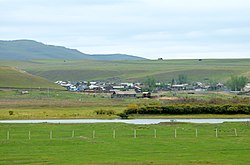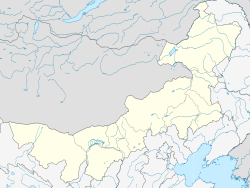|
Ergun City
Ergun (Chinese: 额尔古纳市; Mongolian: ᠡᠷᠬᠥᠨᠠ ᠬᠣᠲᠠ), formerly Ergun Right Banner (Chinese: 额尔古纳右旗), is a county-level city in Hulunbuir, Inner Mongolia, containing the autonomous region's northernmost point. The city has an area of 28,958 square kilometres (11,181 sq mi),[3] and a population of 79,155 as of the 2019.[4]: 20–1 HistoryFor most of its history, the region of present-day Ergun has been governed by ethnic minority regimes.[5] The area first came under Chinese control during the Qing dynasty, when it was administered as part of Hulunbuir.[5] In 1908, the Jilalin Administrative Bureau (Chinese: 吉拉林设治局; pinyin: Jílālín Shèzhì Jú) was established to govern the area.[5] In 1920, the area was re-organized as the Qiqan Administrative Bureau (Chinese: 奇乾设治局; pinyin: Qíqián Shèzhì Jú), but the area was re-organized again in 1921 as Qiqan County (Chinese: 奇乾县; pinyin: Qíqián Xiàn).[5] In 1933, the area was re-organized as Ergun Right Banner (Chinese: 额尔古纳右旗; pinyin: É'ěrgǔnà Yòu Qí).[5] From 1948 to 1966, Ergun Right Banner was merged with Ergun Left Banner, which occupied present-day Genhe, as Ergun Left Banner.[5] In 1994, Ergun Right Banner was abolished and the county-level city of Ergun was established.[5] 21st centuryBy 2000, the city administered five towns, one township, and two ethnic townships.[5] In 2001, the city was restructured to administer one subdistrict, two towns, one township, and two ethnic townships.[5] In 2006, Xincheng Subdistrict (Chinese: 新城街道; pinyin: Xīnchéng Jiēdào) was renamed to Labdalin Subdistrict, and Shangkuli Township (Chinese: 上库力乡; pinyin: Shàngkùlì Xiāng) was upgraded to Shangkuli Subdistrict.[5] In 2011, Shiwei Russian Ethnic Township (Chinese: 室韦俄罗斯族民族乡; pinyin: Shìwéi Èluósī Zú Mínzú Xiāng) was abolished and Enhe Russian Ethnic Township and Mengwu Shiwei Sum were established.[5] Engh Had was also established.[5] In 2013, Qiqan Township was established.[5] GeographyAdministratively, Ergun is part of the prefecture-level city of Hulunbuir, and spans 11.4% of Hulunbuir's area.[3][6] It occupies 28,958 square kilometres (11,181 sq mi), bounded to the north and west by the Argun River, which forms China's border with Russia's Zabaykalsky Krai (formerly, Chita Oblast).[3][7] The city's border with Russia spans 675 kilometres (419 mi).[3] Ergun is also bordered by Genhe to the east, and the county-level city of Mohe in Heilongjiang to the northeast.[3] The city stands at the foothills of the Greater Khingan Mountains.[3] 73.4% of the city's area is forested, with much of it being virgin forests.[3][6] 17% of the city's area is natural grassland, particularly in the city's south, and 6% is cultivated.[3] Apart from the Argun River, major rivers in the city include the Delbur River, the Gen River, the Hawu'er River, the Jiliu River, the Wuma River, and the Engh Had River, all of which are tributaries of the Argun River.[3]
Ergun WetlandsThe city hosts Ergun Wetlands (formerly known as the Genhe Wetlands), a plain delta formed by the Argun River, the Gen River, the Delbur River, and the Hawu'er River.[citation needed] The Ergun Wetlands is one of the largest wetlands in Asia, lying about 3 km to the west of Labdalin Subdistrict, Ergun's urban area and seat of government.[citation needed] After the end of September the wetlands wither and turn dark.[8] A panoramic view of the wetlands is afforded from a tourist scenic view overlooking the area from a hill 720 meters above sea level.[9] The encroachment of urban development has made preservation of the wetland difficult but were bolstered by a wetland protection law in 2012.[10] ClimateThe city experiences an average annual temperature of −3.1 °C (26.4 °F), and an average annual precipitation of 375 millimetres (14.8 in).[3]
Administrative divisionsErgun is divided into 2 subdistricts, 3 towns, 1 township, 2 ethnic townships and 1 sum.[13] The city's seat of government is located in Labdalin Subdistrict.[3][14]
DemographicsErgun is one of the least populated county-level divisions of Inner Mongolia, with a population of 79,155 as of 2019, making it the 87th most populated of the autonomous region's 103 divisions.[4]: 20–1 This figure reflects a 1.0% decline from the 2018 population of 79,942.[4]: 20–37 [15] As of 2010, Ergun had a population of 76,667.[5] Ethnicity
In Ergun's towns and villages along the Argun River are thousands of descendants of intermarriages between Han Chinese men and Russian women.[17] This Russian descended population forms a large portion of the total number of Russians in China. One of these locations is Enhe Russian Ethnic Township, the sole official ethnic Russian township.[17] EconomyErgun's gross domestic product was ¥4.059 billion as of 2019,[4]: 20–37 [18] and ¥4.519 billion as of 2018.[15] As of 2018, 42.1% of the city's gross domestic product came from its primary sector, 11.1% came from its secondary sector, and 46.8% came from its tertiary sector.[15] The city's public budget revenue in 2019 was ¥150.55 million, ranking 91st out of Inner Mongolia's 103 county-level divisions.[4]: 20–4 Its consumer retail sales totaled ¥1.826 billion, and its foreign trade totaled 56.32 million USD.[15]
The average household disposable income of Ergun's residents totaled ¥30,371 in 2019, a 7.8% increase from the ¥28,173 reported in 2018.[4]: 20–37 [15] For urban households, this number stood at ¥30,953 in 2019,[4]: 20–37 a 7.0% increase from the ¥28,928 reported in 2018,[4]: 20–37 [15] which ranked 75th of the 101 county-level divisions in Inner Mongolia for which this statistic was reported.[4]: 20–5 Rural households in Ergun average ¥28,470 in disposable income as of 2019,[4]: 20–37 a 10.0% increase from 2018,[4]: 20–37 which ranked the 3rd highest of the 90 county-level divisions in Inner Mongolia which reported this statistic.[4]: 20–6 As of 2019, there are 99,140 mobile telephone subscriptions in Ergun (1.25 per capita), and 28,962 internet subscriptions (0.37 per capita).[4]: 20–37 Mineral deposits in Ergun include coal, gold, lead, zinc, iron, tungsten, copper, and fluorite.[3] AgricultureThe total value of Ergun's agriculture, forestry, animal husbandry, and aquaculture industry as of 2018 was ¥3.072 billion.[15] In 2019, Ergun produced 263,482 tons of grain, the 37th most of the 96 county-level divisions of Inner Mongolia which reported this statistic.[4]: 20–2 The city produced 9,255 tons of meat the same year, ranking 74th of Inner Mongolia's 103 county-level divisions.[4]: 20–3 TourismErgun has a significant tourism industry, attracting 5.733 million tourists in 2019 alone.[18] The Ergun Wetland Scenic Area (Chinese: 额尔古纳湿地景区) is designated as a AAAA Tourist Attraction.[6] Enhe Russian Ethnic Township has become a major tourist destination in recent years, attracting about 500,000 tourists in 2017 alone.[19] Much of the town's tourism is derived from its small rural character, as well as its unique intersection of Russian and Chinese culture.[19] Due to the cold climate of the region, most of the ethnic township's tourism takes place in summer months.[19] Ergun also hosts the ancient ruins of the city of Heishantou and portions of the Great Wall of Jin.[3] EducationAs of 2019, the city has 10 primary schools and 5 secondary schools.[4]: 20–37 Secondary schools include:[20]
Primary schools include:[20]
HealthcareAs of 2019, Ergun's medical institutions have 414 beds, and are staffed by 597 personnel.[4]: 20–37 TransportationErgun hosts 2,430 kilometres (1,510 mi) of highway as of 2019.[4]: 20–37 Inner Mongolia Provincial Highway 201 and Inner Mongolia Provincial Highway 301 both run through Ergun.[3] Ergun has two international border crossings: one in Shiwei, and another in Heishantou.[7] References
|
|||||||||||||||||||||||||||||||||||||||||||||||||||||||||||||||||||||||||||||||||||||||||||||||||||||||||||||||||||||||||||||||||||||||||||||||||||||||||||||||||||||||||||||||||||||||||||||||||||||||||||||||||||||||||||||||||||||||||||||||||||||||||||||||||||||||||||||||||||||||||||||||||||||||||||||||||||||||||||||||||||||||||||||||||||||||||||||||||||||||||||||||||||||||||||||||||||||||||||||||||||||||||||||||||||||||||||||||||||||||||||||||||||||||||||||||||||||||||||||||||||||||||||||||||||||||||||||||||||||||||||||||||||||||||||||||||||||||||||||||||||||||||||





